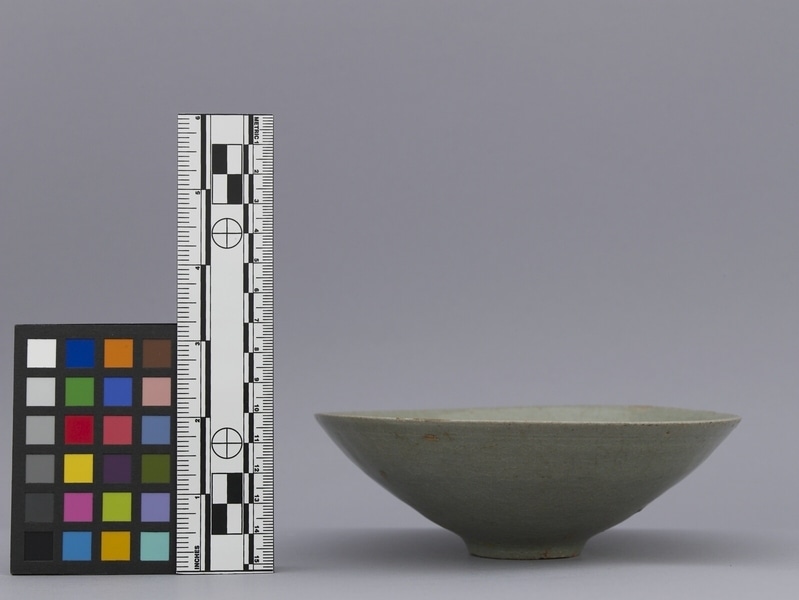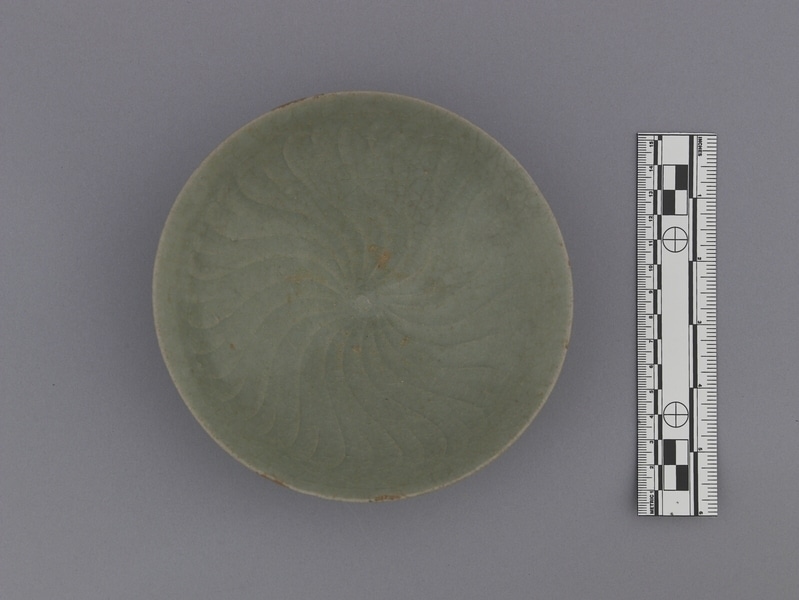Bowl Item Number: N3.93 from the MOA: University of British Columbia



Description
Celadon bowl (wan; 완; 碗). Mould impressed floral design; petal lines radiate out from the centre. Unmarked.
History Of Use
A wide rim ceramic bowl with a narrow bottom and inclined sides is called wan (완; 碗) in Korean. Cheongja wan (청자 완; 靑磁碗) or a wan made of celadon was commonly used for drinking tea during the Goryeo dynasty (918–1392). The shape of this bowl was particularly well-suited for drinking powdered tea, using the tea method that originated in the Tang dynasty of China. Wan was one of the main products in Goryeo celadon kilns, as many Goryeo elites enjoyed drinking tea using this type of bowl. Cheongja wans were usually produced without patterns, but sometimes had decorative patterns reflecting the tastes of noble patrons, likely intended to enhance the drinking experience. All kinds of pottery produced during the Goryeo dynasty (고려; 高麗; 918–1392) are called Goryeo dojagi (Goryeo ware; 고려도자기; 高麗陶磁器). Celadon (green-gray glazed ceramic) known as Goryeo cheongja (고려청자; 高麗青磁) was the main kind of ceramic produced during this period in Korea. Celadon originated in China; Goryeo potters learned the techniques from the celadon traditions of the Song dynasty (960–1279). The Buan (부안군) and Gangjin (강진군) regions in Jeolla Province (전라도) became the major production centre by the mid-twentieth century; Gangjin remains the centre of Goryeo cheongja revival, and modern celadon production. Tea was introduced to Korea during the Tang dynasty (618-907) of China. During the Goryeo dynasty tea was used in royal and Buddhist ceremonies, as well as in daily practice. An establishment called a dabang (다방; 茶房) was established for serving tea. As time passed, drinking tea in daily life thrived among the royal family, nobility, monks and elites. The prevalence of tea drinking and the demand for tea utensils stimulated the development of the Korean ceramics industry, leading to the creation of various types of high-quality tea utensils, such as bowls, cups, cup stands, and ewers.
Narrative
Collected by J. H. Morris while he was chief engineer for Seoul Railway, Korea.
Specific Techniques
This floral design was produced using a mould with intricate patterns. The mould-impression technique is called apchul yanggak (압출양각; 壓出陽刻), and was one of the popular methods used on mid-Goryeo period celadons (12-13th century). It was usually applied to bowls or dishes with a wide shape suitable for using a mould. This technique derived from kilns during the Northern Song dynasty of China (960-1127). This method enabled the mass production of Goryeo celadons with consistent patterns, shape, and quality, to meet the increasing demand for celadons during the mid-Goryeo period. The process of making mould-impressed celadon involves the following: first shaping a vessel and then carving patterns onto the inner surface of the vessel using a sharp tool. Firing the vessel without applying glaze creates a basic mould (모범; 母範). After filling the mould with clay, the resulting piece is dried and removed from the mould. When the piece is fired again without glaze, it becomes a pattern mould (문양범; 文樣範). By pressing another piece of pottery onto the mould with pressure, the embossed pattern is transferred to the inner surface of the new vessel.
Item History
- Made in Korea between 1100 and 1300
- Collected between 1899 and 1939
- Owned by Marion Stephan before August 1964
- Received from Marion Stephan (Donor) during August 1964
What
Who
- Culture
- Korean
- Previous Owner
- Marion Stephan
- Received from
- Marion Stephan (Donor)
Where
- Holding Institution
- MOA: University of British Columbia
- Made in
- Korea
When
- Creation Date
- between 1100 and 1300
- Collection Date
- between 1899 and 1939
- Ownership Date
- before August 1964
- Acquisition Date
- during August 1964
Other
- Item Classes
- ceramics
- Condition
- good
- Accession Number
- 0113/0107